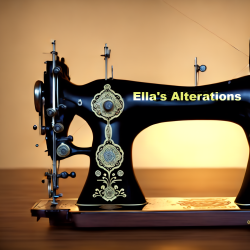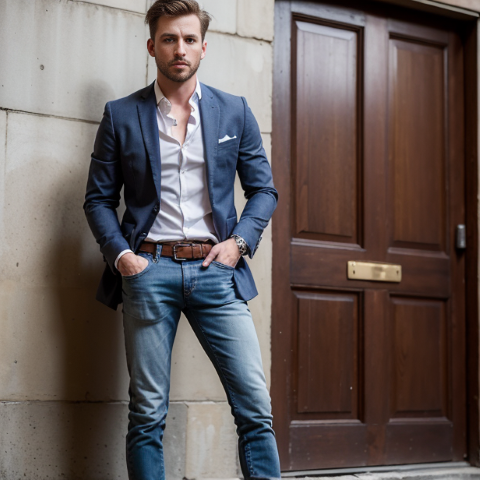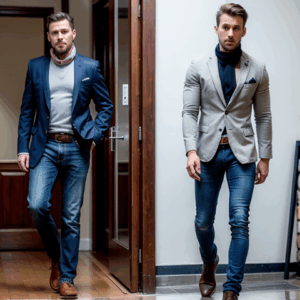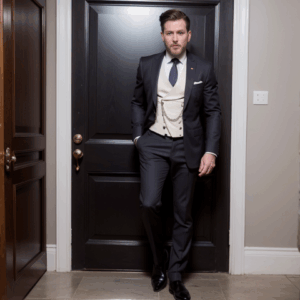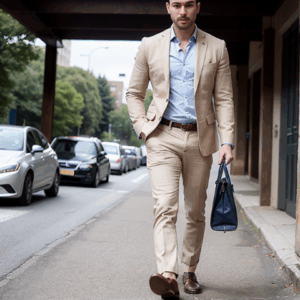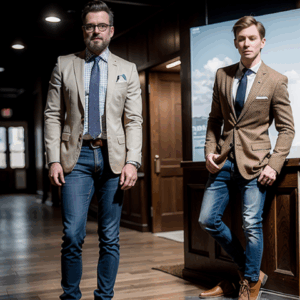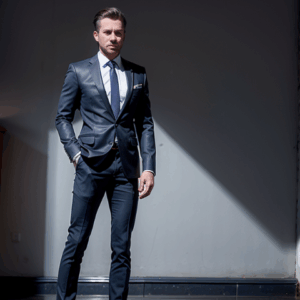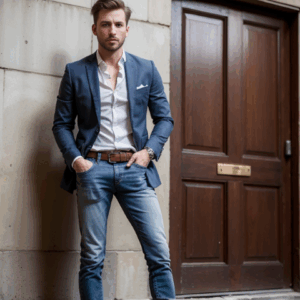The Art of Altering Men’s Clothing: From Casual to Formal. | ||
|---|---|---|
Introduction:The Art of Altering Men’s Clothing: From Casual to Formal. Background: Purpose and Scope: Methodology: This blog is structured to provide a holistic understanding of the topic. It begins by exploring the fundamental aspects of understanding garment structure, including fabrics and materials, silhouettes and fit, and construction techniques. This foundation sets the stage for the subsequent sections, which delve into key alteration techniques, such as hemming and length adjustments, waist and seat alterations, sleeve modifications, shoulder and jacket alterations, and collar and neckline adjustments. These techniques are explored in detail, providing insights into the craftsmanship and precision required to achieve seamless alterations. This blog then delves into the considerations involved in transforming casual outfits to formal ensembles. It explores concepts such as color and pattern coordination, fabric selection, and the role of accessories and accents in elevating the overall formality of an outfit. Understanding these elements is crucial in achieving successful transformations. The subsequent section focuses on mastering tailoring techniques. It explores the art of hand stitching and machine stitching, working with different fabrics, understanding proportions and balance, and troubleshooting common alteration challenges. This section equips readers with the technical knowledge and skills necessary to execute professional alterations. To provide practical application, the essay includes case studies that illustrate the transformation of specific garments from casual to formal. These case studies highlight the techniques employed and the impact of alterations on the overall appearance and formality of the outfits. The importance of personal style is also emphasized throughout the essay. The section dedicated to personal style explores how individuals can express their individuality through clothing, highlighting the role of confidence and self-presentation in the art of altering men’s clothing. This Blog summarizes the key points discussed, emphasizing the enduring significance of the art of altering men’s clothing. It also offers insights into future trends and innovations that may shape the field of garment alterations. By providing a comprehensive exploration of the art of altering men’s clothing, this essay aims to inspire readers to embrace this skill as a means of enhancing their personal style, adapting to different occasions, and expressing their individuality. | ||
| ||
Understanding Garment Structure:Fabrics and Materials: For example, cotton fabrics are versatile and commonly used in men’s clothing. They can be easily manipulated and altered, making them suitable for various styles and occasions. Wool, on the other hand, is known for its durability, insulation, and natural elasticity. Tailoring garments made from wool requires attention to detail to preserve its unique properties. Understanding the characteristics of different materials enables tailors to select appropriate alteration techniques and make adjustments that maintain the integrity and quality of the fabric. They must consider factors such as fabric weight, stretch, drape, and texture when determining the best approach to alter a garment effectively. Silhouettes and Fit: Formal attire often features a more structured and fitted silhouette. Trousers may have a slimmer leg, jackets may be more tapered at the waist, and shirts may have a closer fit. On the other hand, casual attire may allow for a looser and more relaxed silhouette. Understanding the nuances of various silhouettes and the impact they have on fit enables tailors to modify garments to enhance the wearer’s physique and achieve the desired level of formality. This includes considerations such as waist suppression, shoulder expression, sleeve length, and overall proportions. Construction Techniques: Seams are the primary method of joining fabric panels together, and tailors must understand their placement and purpose to alter garments effectively. They may need to open seams and re-stitch them to adjust the garment’s size or reshape specific areas. Darts are triangular folds in the fabric that provide shape and contouring. Tailors may need to alter the position or size of darts to achieve a better fit, especially in areas like the waist or back of a jacket. Linings and interlinings, which are used in jackets and coats, also influence the alteration process. Tailors must consider the impact of modifying these components on the overall structure and appearance of the garment. By understanding construction techniques, tailors can manipulate and modify garments while maintaining their original integrity. They can identify potential limitations and determine the best approach to achieve the desired alterations without compromising the garment’s structure. By developing a comprehensive understanding of garment structure, including fabrics, silhouettes, and construction techniques, tailors can execute alterations with precision and finesse. This knowledge forms the foundation for transforming casual men’s clothing into formal ensembles, ensuring that the garments not only fit well but also reflect the desired level of formality. | ||
| ||
| Ella’s Alterations LLC 813-445-8894 https://ellasalterations.com | ||
Key Alteration Techniques:Hemming and Length Adjustments: When hemming trousers, tailors carefully measure and mark the desired length before cutting and reattaching the hem. They take into account factors such as the break (the fold or crease at the bottom of the trouser leg) and the wearer’s height and personal style preferences. Similarly, when altering the length of sleeves on shirts, jackets, or coats, tailors measure and mark the desired length before adjusting the hemline. Sleeve length should complement the wearer’s arm length and proportions, allowing for comfortable movement and a polished appearance. Waist and Seat Alterations: When altering trousers, tailors can modify the waist by adjusting the side seams or using waistband extensions. This alteration ensures a snug fit around the waist without excessive looseness or tightness. For jackets and coats, seat alterations focus on adjusting the fabric around the hips and buttocks. Tailors may need to take in or let out the side seams, darts, or center-back seam to achieve an optimal fit that provides both comfort and a streamlined appearance. Sleeve Modifications: When altering sleeve length, tailors take into account factors such as the wearer’s arm length, the desired amount of cuff exposure, and the overall proportions of the garment. Careful measurement and precise cutting ensure that the sleeves are adjusted accurately without distorting the garment’s balance. Tapering or widening sleeves involves adjusting the circumference from the shoulder to the wrist. Tailors may need to take in or let out the sleeve seams, gradually tapering or widening them to achieve a balanced and flattering fit. Shoulder and Jacket Alterations: Tailors may need to alter the shoulder seam, the position of the sleeve head, or even reshape the shoulder pad to achieve the desired fit. These alterations ensure that the jacket sits properly on the wearer’s shoulders, without any excess fabric or pulling. In addition to shoulder alterations, tailors may also need to adjust the jacket’s overall fit. This can involve taking in or letting out the side seams, adjusting the waist suppression, or modifying the back darts to achieve a tailored and polished appearance. Collar and Neckline Adjustments: By adjusting the collar’s position and shape, tailors can enhance the overall aesthetics of a garment and ensure a comfortable fit. This alteration may involve reshaping the collar, modifying the collar stand, or even repositioning the collar to achieve the desired look. Neckline adjustments are particularly important in achieving a balanced and flattering fit. Tailors may need to alter the neckline by adjusting the shoulder seams or reshaping the collar to ensure that it rests properly against the wearer’s neck without being too tight or loose. By mastering these key alteration techniques, tailors can transform men’s clothing from casual to formal with precision and skill. These techniques allow for the customization and refinement of garments, ensuring that they fit well, complement the wearer’s body shape, and reflect the desired level of formality. | ||
| ||
| The Craftsmanship of Alterations: Behind the Scenes with an Expert. | ||
| Ella’s Alterations LLC 813-445-8894 https://ellasalterations.com | ||
Considerations for Casual-to-Formal Transformations:Color and Pattern Coordination: Tailors should guide clients on selecting colors that are appropriate for the desired level of formality. They may recommend darker hues for a more formal look or suggest incorporating complementary shades to add depth and visual interest. Patterns can also play a role in elevating the formality of an outfit. While casual attire may embrace bolder patterns and prints, formal ensembles tend to favor more subtle patterns like pinstripes, herringbone, or checks. Tailors can advise clients on suitable patterns that enhance the overall formality while maintaining a sense of style. Fabric Selection: Tailors should recommend fabrics that offer a polished and sophisticated appearance. They should guide clients away from overly casual fabrics such as denim or heavy twills, which are more suited for casual outfits. Additionally, fabric weight should be considered. Lighter fabrics with a finer weave are often preferred for formal attire as they provide a sleeker and more elegant look. Heavier fabrics can be reserved for more casual or seasonal outfits. Role of Accessories and Accents: Tailors can guide clients in selecting appropriate accessories such as ties, pocket squares, belts, and cufflinks. Ties made from silk or fine wool in classic patterns like solids, stripes, or subtle motifs are ideal for formal occasions. Pocket squares, either matching or contrasting with the tie, can add a touch of elegance to a jacket. Belts and cufflinks should be chosen with attention to detail, matching the overall color scheme and style of the outfit. Tailors can suggest leather belts in darker shades and simple, understated cufflinks that complement the attire without overpowering it. Balance Between Comfort and Formality: Tailors should ensure that the alterations do not restrict the wearer’s range of motion. Proper fit in the shoulders, arms, and waist, along with appropriate ease in the trouser seat and thighs, allows for both comfort and a polished appearance. Moreover, the selection of appropriate fabrics, such as those with natural stretch or breathability, can contribute to the overall comfort of the outfit. Tailors should prioritize the client’s comfort while achieving the desired level of formality. Occasion and Dress Code: For formal events such as black-tie galas or weddings, tailors may recommend traditional tuxedos or formal suits with peak lapels and satin details. On the other hand, for semi-formal occasions like cocktail parties or business events, tailors can suggest tailored suits in classic colors with subtle details. By considering the occasion and dress code, tailors can ensure that the alterations align with the specific requirements, creating a seamless transition from casual to formal attire. By taking these considerations into account, tailors can assist clients in achieving successful casual-to-formal transformations. Through careful color and pattern coordination, fabric selection, appropriate accessorizing, maintaining a balance between comfort and formality, and adhering to the occasion and dress code, tailors can help individuals create polished and refined ensembles that are suited for formal settings. | ||
| ||
Mastering Tailoring Techniques:Hand Stitching: Tailors should master various hand stitching techniques, including the slip stitch, catch stitch, and blind hem stitch. These techniques are used for tasks such as attaching hems, securing linings, closing seams, and hand-finishing details. The slip stitch is commonly used for hemming and attaching linings. It involves creating nearly invisible stitches that hold the fabric securely while remaining hidden from view. The catch stitch is ideal for securing seams, particularly in areas that require flexibility, such as the waistband or underarm seams. The blind hem stitch allows for a discreet and barely noticeable finish when hemming trousers or sleeves. By mastering hand stitching techniques, tailors can ensure that alterations are seamlessly integrated into the garment, preserving its original appearance and structure. Machine Stitching: Tailors should familiarize themselves with different machine stitches and settings, ensuring they have a good understanding of the appropriate tension and stitch length for different fabrics. When using a sewing machine for alterations, tailors should pay attention to maintaining a straight and even stitch line. This ensures a professional and consistent finish throughout the garment. While machine stitching is often used for basic alterations such as shortening hems or adjusting waistbands, tailors should combine both hand and machine stitching techniques to achieve the best results. Working with Different Fabrics: Tailors should understand the characteristics of different fabrics, such as their stretch, stability, and propensity for fraying. They should adapt their techniques accordingly to ensure the fabric is not damaged during the alteration process. For delicate fabrics like silk or chiffon, tailors may need to use finer needles, lighter threads, and more delicate stitches to avoid puckering or creating visible marks. On the other hand, when working with heavier fabrics like tweed or denim, tailors may need to use stronger needles and thicker threads to handle the fabric’s weight. Tailors should also take into account fabric patterns when altering garments. They should ensure that pattern alignment is maintained, especially in areas such as pockets or seams, to preserve the garment’s overall aesthetics. By developing expertise in working with different fabrics, tailors can execute alterations with precision and confidence, ensuring that the fabric’s integrity is maintained throughout the process. Understanding Proportions and Balance: Tailors should pay attention to the overall balance of the garment, ensuring that it complements the wearer’s physique. This includes considering factors such as the relationship between the jacket’s length and the wearer’s torso, or the proper placement of waist suppression to create a visually pleasing silhouette. Additionally, tailors should consider individual body variations, such as sloping or square shoulders, a prominent chest, or a rounded back. These variations may require specific alterations, such as adjusting the shoulder line or adding extra room in certain areas, to achieve an optimal fit. By understanding proportions and balance, tailors can create alterations that flatter the wearer’s body shape and create a harmonious overall appearance. Troubleshooting Common Alteration Challenges: Tailors should be equipped with problem-solving techniques to address these challenges effectively. This may involve creative pattern-making, such as adding or removing darts, altering seam placements, or reshaping certain areas of the garment. For intricate designs or details, tailors should exercise caution and meticulousness to maintain the integrity of the original design. They may need to disassemble and reassemble certain sections of the garment, ensuring that no details are compromised during the alteration process. When correcting previous alterations, tailors should carefully assess the existing alterations and determine the best approach for rectifying any issues. This may involve undoing and redoing previous stitching, adjusting proportions, or rethinking the alteration strategy. By mastering troubleshooting techniques, tailors can navigate through common alteration challenges with confidence and ensure that the final result meets the client’s expectations. By mastering the art of tailoring techniques, tailors can elevate their craftsmanship and deliver high-quality alterations that transform men’s clothing from off-the-rack to custom-fitted. Through proficiency in hand and machine stitching, understanding different fabrics, grasping proportions and balance, and troubleshooting common challenges, tailors can create well-tailored garments that flatter the wearer’s body shape, enhance their style, and provide a comfortable fit. | ||
| ||
| ||
| The Art of Aesthetic Alterations: Tips for a Fashionable Wardrobe. | ||
Case Studies: Transforming Casual to Formal:To illustrate the art of transforming casual clothing into formal attire, let’s explore two case studies that showcase the power of expert alterations. Case Study 1: From Casual Shirt to Formal Dress Shirt: John, a client attending a black-tie event, wants to transform his casual shirt into a formal dress shirt. The original shirt is made of a lightweight cotton fabric with a relaxed fit, making it unsuitable for formal occasions. The tailor begins by assessing the shirt’s structure and fit. They identify key areas for alteration, including the shoulders, sleeves, and torso. First, the tailor alters the shoulders by reshaping and narrowing them to create a cleaner and more structured silhouette. They carefully remove excess fabric from the shoulder seams while ensuring that the armholes maintain the correct proportions. Next, the tailor focuses on the sleeves. They shorten the sleeves to the appropriate length, allowing for a precise cuff exposure when John wears a suit jacket. The sleeves are tapered slightly from the elbow to the cuff to achieve a slimmer and more formal look. To enhance the shirt’s overall fit, the tailor takes in the torso by adjusting the side seams. This alteration provides a more streamlined appearance and eliminates any excess fabric that can give a casual impression. Finally, the tailor replaces the original plastic buttons with more elegant buttons made of mother-of-pearl. This small detail adds a touch of sophistication and elevates the overall aesthetic of the shirt. Through these expert alterations, the casual shirt is transformed into a well-fitted formal dress shirt. The tailored fit, refined shoulders, tapered sleeves, and upgraded buttons combine to create an ensemble that exudes elegance and is suitable for the black-tie event. Case Study 2: From Casual Trousers to Formal Pants: David, a client attending a formal business function, seeks to convert his casual trousers into a pair of formal pants. The original trousers are made of a lightweight cotton fabric with a loose fit, making them inappropriate for a professional setting. The tailor begins by assessing the trousers’ structure and fit, identifying the areas that require alteration. First, the tailor focuses on the waist and seat. They take in the waistband to achieve a slimmer fit around David’s waist. This alteration ensures that the trousers sit comfortably and securely without the need for a belt. To enhance the fit around the hips and buttocks, the tailor adjusts the seat by tapering the side seams. This alteration creates a more streamlined appearance and prevents any excess fabric from bunching or sagging. Next, the tailor addresses the length of the trousers. They measure and mark the desired length, taking into account David’s height and the desired break. The trousers are then carefully hemmed, ensuring a clean and polished finish. Finally, the tailor adds a discreet cuff at the bottom of the trousers. This small detail adds a touch of sophistication and distinguishes the formal pants from their casual counterparts. Through these alterations, the casual trousers are transformed into a pair of formal pants suitable for a professional setting. The tailored waist and seat, the appropriate trouser length with a clean hem, and the addition of a cuff create a polished and refined look that aligns with the formal dress code. In both case studies, the expert alterations showcase the art of transforming casual clothing into formal attire. Through precise measurements, skilled modifications, and attention to detail, tailors can create customized garments that meet the client’s desired level of formality, providing a seamless transition from casual to formal wear. By leveraging their expertise and craftsmanship, tailors play a vital role in helping individuals elevate their style and confidently present themselves in formal settings. | ||
| Ella’s Alterations LLC 813-445-8894 https://ellasalterations.com | ||
| ||
The Importance of Personal Style:While mastering the art of altering men’s clothing from casual to formal is essential, it is equally important to honor and embrace the client’s personal style. Personal style reflects an individual’s personality, preferences, and unique fashion sensibilities. Tailors should prioritize understanding and incorporating personal style into the transformation process to ensure that the final result not only meets formal requirements but also resonates with the client’s identity. Enhancing Individuality: Tailors should engage in conversations with clients to understand their style preferences, favorite colors, patterns, and even cultural influences. This information helps tailor the alterations to align with the client’s personal style, resulting in a transformed outfit that feels like a true representation of their individuality. Customizing Details: For example, if a client has a penchant for vintage aesthetics, a tailor can incorporate vintage-inspired buttons, lapel styles, or pocket square options into the formal garment. If a client prefers a more modern and minimalist look, the tailor can suggest clean lines, monochromatic color schemes, and minimal embellishments. Tailors should also consider the client’s body shape and proportions when customizing details. This includes recommending specific lapel widths, tie widths, or trouser pleating styles that flatter the client’s physique while aligning with their personal style. Balancing Formality and Personal Expression: This can be achieved by integrating personal style through subtle details or accessories. For example, incorporating a colorful pocket square, a distinctive tie pattern, or a unique cufflink design can add a touch of personal flair to a formal ensemble without compromising its overall formality. Tailors should guide clients on how to tastefully infuse their personal style into the formal attire, ensuring that it enhances the overall look without overpowering it. The goal is to create a harmonious blend of formality and self-expression. Boosting Confidence and Comfort: Tailors should create an environment where clients feel comfortable expressing their personal style preferences. They should provide guidance and suggestions while also valuing the client’s input and ensuring their comfort throughout the alteration process. By honoring personal style, tailors can empower clients to embrace their individuality, boosting their confidence and creating a sense of ownership over their formal attire. Evolving Personal Style: Tailors can maintain a long-term relationship with their clients, providing ongoing support and advice as their personal style evolves. By staying updated on emerging fashion trends, tailors can suggest alterations or modifications that align with the client’s changing preferences while still maintaining a formal aesthetic. Tailors can also offer personalized styling consultations, recommending complementary garments, colors, or accessories that enhance the client’s evolving personal style. This collaborative approach ensures that the client’s formal wardrobe remains current, stylish, and aligned with their unique fashion journey. Personal style is an integral aspect of the art of altering men’s clothing from casual to formal. Tailors should prioritize understanding and incorporating personal style throughout the alteration process. By enhancing individuality, customizing details, balancing formality and personal expression, boosting confidence and comfort, and adapting to evolving personal style, tailors can create transformative garments that not only meet formal requirements but also reflect the client’s authentic self. | ||
| ||
Conclusion:The art of altering men’s clothing from casual to formal requires a combination of technical skill, creativity, and a deep understanding of personal style. Throughout this essay, we have explored various aspects of this art form, including understanding garment structure, key alteration techniques, considerations for casual-to-formal transformations, mastering tailoring techniques, case studies, and the importance of personal style. Tailors play a pivotal role in helping individuals transform their clothing to suit formal occasions. By mastering the techniques of hand stitching and machine stitching, tailors can achieve precise and invisible alterations that maintain the integrity of the garment. They must also be adept at working with different fabrics, understanding their characteristics, and adapting their techniques accordingly. Furthermore, tailors must have a keen eye for proportions and balance, ensuring that garments flatter the wearer’s body shape and create a harmonious appearance. Troubleshooting common alteration challenges is also crucial to overcome any obstacles that may arise during the transformation process. The importance of personal style cannot be understated in the art of altering men’s clothing. Tailors should prioritize understanding and incorporating the client’s personal style, enhancing their individuality, customizing details, and striking a balance between formality and personal expression. By doing so, they can create garments that not only meet formal requirements but also resonate with the client’s identity. Ultimately, the art of transforming casual clothing into formal attire is about more than just altering fabric and structure. It is about empowering individuals to feel confident, comfortable, and authentic in their formal wear. Tailors serve as partners in this process, guiding clients and supporting their evolving personal style. In conclusion, the art of altering men’s clothing from casual to formal is a skillful craft that requires technical expertise, an understanding of personal style, and a commitment to enhancing the individual’s confidence and self-expression. Tailors who embrace this art form have the power to transform garments into personalized works of art, allowing individuals to present themselves with style, elegance, and authenticity in formal settings. The Art of Altering Men’s Clothing: From Casual to Formal. #MensFashion #Tailoring #FormalAttire #StyleTransformation #PersonalStyle #ArtOfAlterations #CustomFitting #FashionCraftsmanship #ElevateYourStyle #SartorialElegance #TailoredPerfection #DapperGentleman #FashionForward #MensStyleGuide #AlterationTechniques #CasualToFormal #ConfidenceInStyle #FashionEvolution #PersonalizedFashion #FashionJourney #EllasAlterationsLLC | ||
| ||
| ||
| Ella’s Alterations LLC 813-445-8894 https://ellasalterations.com | ||
| The Science of Alterations: Perfecting Men’s Clothing. | ||
|
